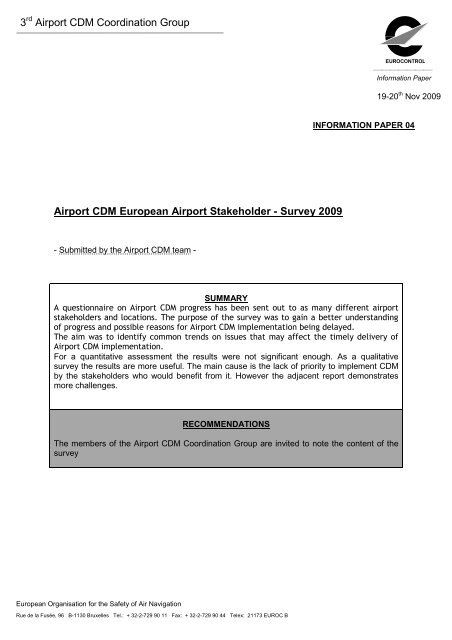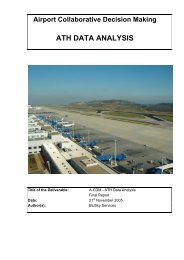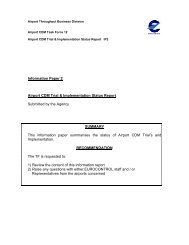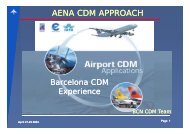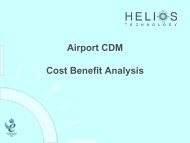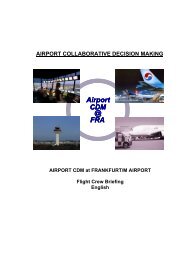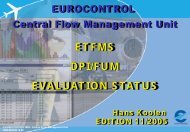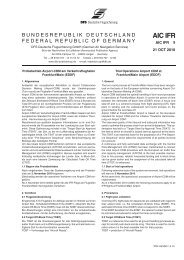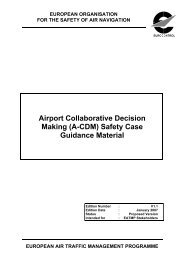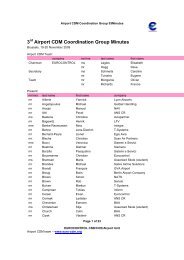IP04 survey A-CDM - Airport Collaborative Decision Making
IP04 survey A-CDM - Airport Collaborative Decision Making
IP04 survey A-CDM - Airport Collaborative Decision Making
You also want an ePaper? Increase the reach of your titles
YUMPU automatically turns print PDFs into web optimized ePapers that Google loves.
3 rd <strong>Airport</strong> <strong>CDM</strong> Coordination Group<br />
<strong>Airport</strong> <strong>CDM</strong> European <strong>Airport</strong> Stakeholder - Survey 2009<br />
- Submitted by the <strong>Airport</strong> <strong>CDM</strong> team -<br />
European Organisation for the Safety of Air Navigation<br />
Rue de la Fusée, 96 B-1130 Bruxelles Tel.: + 32-2-729 90 11 Fax: + 32-2-729 90 44 Telex: 21173 EUROC B<br />
E U R O C O N T R O L<br />
⎯⎯⎯⎯⎯⎯⎯<br />
Information Paper<br />
19-20 th Nov 2009<br />
INFORMATION PAPER 04<br />
SUMMARY<br />
A questionnaire on <strong>Airport</strong> <strong>CDM</strong> progress has been sent out to as many different airport<br />
stakeholders and locations. The purpose of the <strong>survey</strong> was to gain a better understanding<br />
of progress and possible reasons for <strong>Airport</strong> <strong>CDM</strong> implementation being delayed.<br />
The aim was to identify common trends on issues that may affect the timely delivery of<br />
<strong>Airport</strong> <strong>CDM</strong> implementation.<br />
For a quantitative assessment the results were not significant enough. As a qualitative<br />
<strong>survey</strong> the results are more useful. The main cause is the lack of priority to implement <strong>CDM</strong><br />
by the stakeholders who would benefit from it. However the adjacent report demonstrates<br />
more challenges.<br />
RECOMMENDATIONS<br />
The members of the <strong>Airport</strong> <strong>CDM</strong> Coordination Group are invited to note the content of the<br />
<strong>survey</strong>
- 2 -<br />
<strong>Airport</strong> <strong>CDM</strong> European <strong>Airport</strong> Stakeholder -<br />
Survey 2009<br />
Survey purpose<br />
The purpose of the <strong>survey</strong> was to gain a better understanding of progress and the potential<br />
blocking points in the implementation of <strong>Airport</strong> <strong>Collaborative</strong> <strong>Decision</strong> <strong>Making</strong> (A-<strong>CDM</strong>)<br />
and more importantly an insight as where the current A-<strong>CDM</strong> practitioners viewed the<br />
challenges ahead. The questionnaire was focused at a broad range of airport locations and<br />
stakeholders across Europe. The aim was to identify common trends on issues that may<br />
affect the timely delivery of A-<strong>CDM</strong> implementation.<br />
<strong>Airport</strong> <strong>CDM</strong> aims to enhance operational efficiency at airports through improved decision<br />
making capabilities and the integration of airport operations into the ATM Network by<br />
enhanced cooperation and coordination. It involves the sharing of accurate and timely<br />
operational data between Air Traffic Management, Aircraft Operators, CFMU, Ground<br />
Handlers, <strong>Airport</strong>s and other service providers. Therefore, to better understand the<br />
current status of implementation enables all stakeholders to focus their efforts on the<br />
important issues and share common solutions to overcome any potential blocking points<br />
ahead.<br />
As part of the data gathering exercise, an online web page was developed so that<br />
respondents could answer the list of questions easily and anonymously. The individual<br />
results from individual stakeholders will remain confidential. A copy of the questionnaire<br />
can be found in APPENDIX A
The Survey details<br />
- 3 -<br />
• The questionnaires were sent to 27 <strong>Airport</strong> locations, representing 19 ANSP’s, 14<br />
Airlines, 17 airport operators, 2 ground Handlers and other stakeholders in mid<br />
2009.<br />
• The <strong>survey</strong> focused on identifying the current status of A-<strong>CDM</strong> roll-out across<br />
Europe and to test what was perceived to be the blocking points currently being<br />
experienced, and what could potentially frustrate the timely implementation of A-<br />
<strong>CDM</strong>.<br />
Analysis method<br />
• All responses to the questionnaire have been consolidated into a MS-Excel<br />
spreadsheet and formatted to improve the presentation and readability of the<br />
results.<br />
• In order to perform a detailed quantitative data analysis of the responses, each of<br />
the response criteria was assigned a number ranging from 1 to 5, as shown below:<br />
o 1: Fully disagree<br />
o 2: Disagree<br />
o 3: No opinion<br />
o 4: Agree<br />
o 5: Fully agree<br />
• Comments made in the ‘Other reasons’ field are helpful to better understand and<br />
add context to the rest of the answers and the current situation at the airport<br />
concerned.<br />
For the statistical analysis; see APPENDIX B
Survey Response summary<br />
- 4 -<br />
• An encouraging 35 responses were received in total from 19 different airport<br />
locations spread across Europe.<br />
• An ANSP responsible for 4 airports gave the same generic response for all 4 airports.<br />
• Two airport locations provided anonymous responses, however, it was confirmed<br />
that the information received was from the airport operator and an airline.<br />
• Only 3 airports were represented by 3 or more different types of partners.<br />
• 2 different replies came from the same airport partner at the same airport<br />
location.<br />
• 2 replies were received from participants claiming that they were representing all<br />
the partners of the <strong>Airport</strong> <strong>CDM</strong> project.<br />
• There was a good distribution between <strong>Airport</strong> Operators (13) and ANSPs (14), plus<br />
other responses from airlines (6), a Ground Handler and a Slot Coordination<br />
organisation.<br />
• The average of the answers to only 5 statements could be considered as significant<br />
indication:<br />
o To the statement ‘Possible reasons for <strong>Airport</strong> <strong>CDM</strong> project implementation<br />
Number of answers<br />
being delayed: difficulties establishing which partner will drive or lead the<br />
project’ the participants disagreed with the statement.<br />
12<br />
10<br />
8<br />
6<br />
4<br />
2<br />
0<br />
12<br />
Possible reasons for <strong>Airport</strong> <strong>CDM</strong> project implementation being delayed<br />
Political reasons<br />
9<br />
Fully disagree Disagree No opinion Agree Fully agree<br />
Type of answer<br />
1<br />
9<br />
2<br />
Difficulties establishing<br />
which partner will drive<br />
or lead the project
- 5 -<br />
o To the statement ‘Possible reasons for <strong>Airport</strong> <strong>CDM</strong> project implementation<br />
Number of answers<br />
Number of answers<br />
being delayed: fear of confidentiality violation’ the participants disagreed with<br />
the statement.<br />
18<br />
16<br />
14<br />
12<br />
10<br />
8<br />
6<br />
4<br />
2<br />
0<br />
8<br />
Possible reasons for <strong>Airport</strong> <strong>CDM</strong> project implementation being delayed<br />
Political reasons<br />
18<br />
Fully disagree Disagree No opinion Agree Fully agree<br />
Type of answer<br />
1<br />
6<br />
0<br />
Fear of confidentiality violation<br />
o To the statement ‘Possible reasons for <strong>Airport</strong> <strong>CDM</strong> project implementation<br />
14<br />
12<br />
10<br />
8<br />
6<br />
4<br />
2<br />
0<br />
being delayed: lack of involvement of the higher management of your own<br />
company’ the participants disagreed with the statement.<br />
10<br />
Possible reasons for <strong>Airport</strong> <strong>CDM</strong> project implementation being delayed<br />
Political reasons<br />
13<br />
4 4<br />
Fully disagree Disagree No opinion Agree Fully agree<br />
Type of answer<br />
2<br />
Lack of involvement of<br />
the higher management<br />
of your own company
Number of answers<br />
Number of answers<br />
- 6 -<br />
o To the statement ‘Possible reasons for <strong>Airport</strong> <strong>CDM</strong> project implementation<br />
18<br />
16<br />
14<br />
12<br />
10<br />
8<br />
6<br />
4<br />
2<br />
0<br />
being delayed: following implementation, data accuracy, timeliness and<br />
availability deteriorates’ the participants had no opinion on the statement.<br />
3<br />
Possible reasons for <strong>Airport</strong> <strong>CDM</strong> project implementation being delayed<br />
Operational reasons<br />
9<br />
Fully disagree Disagree No opinion Agree Fully agree<br />
Type of answer<br />
17<br />
4<br />
0<br />
Following implementation,<br />
data accuracy, timeliness<br />
and availability deteriorates<br />
The result may be explained by the fact that implementation is still ongoing<br />
at most of the respondent airport locations.<br />
o To the statement ‘Possible reasons for <strong>Airport</strong> <strong>CDM</strong> project implementation<br />
10<br />
9<br />
8<br />
7<br />
6<br />
5<br />
4<br />
3<br />
2<br />
1<br />
0<br />
being delayed: unforeseen withdrawal of a major partner’ the participants<br />
disagreed with the statement.<br />
Possible reasons for <strong>Airport</strong> <strong>CDM</strong> project implementation being delayed<br />
General reasons<br />
10 10<br />
9<br />
2 2<br />
Fully disagree Disagree No opinion Agree Fully agree<br />
Type of answer<br />
Unforeseen withdrawal<br />
of a major partner
- 7 -<br />
• The following chart shows the distribution of the “agree” and “fully agree”<br />
responses to the proposed statements. It gives an indication of the most frequent<br />
reasons for delay in the implementation of <strong>Airport</strong> <strong>CDM</strong>:<br />
Distribution of the "Agree" and "Fully agree" responses to the proposed statements<br />
Number of answers<br />
20<br />
18<br />
16<br />
14<br />
12<br />
10<br />
8<br />
6<br />
4<br />
2<br />
0<br />
Project priority<br />
Costs not clear<br />
Benefits not clear<br />
Economic crisis<br />
Funding<br />
No MoU<br />
No Project Manager<br />
No partner leading<br />
Confidentiality violation<br />
Relations btw partners<br />
Higher mgmt involvmt<br />
Milestones & procedures<br />
Project mgmt issues<br />
Poor data sharing<br />
Poor data quality<br />
Procedures implementation<br />
Poor involvement of ops<br />
IT issues<br />
Poor commitment<br />
Poor awareness<br />
Conflicting priorities<br />
Partners not convinced<br />
Withdrawal of partner<br />
Fear of change<br />
Statements<br />
o The chart shows that budgetary reasons, lack of commitment and<br />
conflicting priorities are playing an important role. The current economic<br />
crisis affecting one or more of the airport partners and project funding<br />
issues were seen as delaying factors for A-<strong>CDM</strong> implementation.<br />
o It also seems that <strong>Airport</strong> <strong>CDM</strong> is not always considered as being a priority at<br />
the different airports, seeing the number of responses considering that the<br />
lack of Project Manager, lack of commitment and difficulties in convincing<br />
some partners to participate are issues.<br />
o Technical issues such as integration and development of systems also seem<br />
to cause difficulties.<br />
'Agree' & 'Fully agree'<br />
statements
- 8 -<br />
• Generally, a positive response and the comments appear to be well balanced and<br />
open to reflect the current challenges facing all sectors of the aviation industry.<br />
• 6 participants from 4 different airports considered that the project had been<br />
stopped vs. 29 from 17 different airports who considered that it had not.<br />
• There was a wide geographical spread in the responses and it is also representative<br />
of a range of airport sizes.<br />
• Inconsistencies in the replies at the same airport and sometimes within the same<br />
organisation were observed. In particular, inconsistencies have been observed in<br />
the start date of the project, implementation stage and whether the project has<br />
been stopped.<br />
Key findings (qualitative analysis)<br />
• There appears to be continued positive intent to implement A-<strong>CDM</strong> at a number of<br />
airports across Europe, with some States being more proactive and showing more<br />
progress than others.<br />
• For a number of reasons there are still some blocking points delaying the<br />
implementation process in other areas. From the comments written in the free text<br />
section, it seems that they fall mainly into three categories:<br />
o Lack of Commitment by some stakeholders (implementation only on<br />
voluntary basis)<br />
o Lack of awareness by some decision makers of the benefits<br />
o The current economical climate is challenging<br />
Commitment by some stakeholders<br />
• Whilst some elements of the <strong>Airport</strong>/ANSP/Airline tripartite organisation needed to<br />
implement A-<strong>CDM</strong> and are fully motivated and willing to participate, others are still<br />
not as committed or willing to contribute.<br />
• Conflicting priorities have been amplified especially due to the current state of the<br />
aviation market.<br />
• The challenge of changing organisational cultures and working practices is too great<br />
at this time.<br />
Lack of awareness by some decision makers of the benefits<br />
• Whilst there is a positive outlook towards A-<strong>CDM</strong>, the full benefits to some are still<br />
an unknown entity and difficult to quantify.
- 9 -<br />
• There is still a question of ‘why change’ when the current system works.<br />
• Some organisations are still focused on their internal priorities.<br />
The current economical climate<br />
• Whilst there are recognised benefits from A-<strong>CDM</strong>, there is a lack of willingness to<br />
expend funds on what can be seen as not a core or mandated project.<br />
• With current pay freezes, staff reductions and general staff relations being tested,<br />
there may be a reluctance to implement an operational change process that could<br />
be seen as a transformation of working practices.<br />
• With most airports experiencing a significant down turn in traffic demand and<br />
revenues, any additional funding or allocation of resources is unlikely to be<br />
approved.<br />
Conclusions<br />
• Given the volume of the responses there is obviously a great interest to still pursue<br />
the implementation of A-<strong>CDM</strong> at many airports, even if other projects take a higher<br />
priority.<br />
• The challenge of implementation and the introduction of new processes,<br />
collaborative working practices and general cultural changes are still seen as a<br />
major obstacle for some organisations.<br />
• The awareness of the operational, financial and probably more importantly the<br />
environmental and sustainable development benefits are still unclear for many.<br />
• With the general on-going delays in implementing A-<strong>CDM</strong> across Europe there is a<br />
Next steps<br />
growing risk to achieving the SESAR baseline expectations for <strong>Airport</strong>s. However,<br />
with reduced traffic at a majority of airports, there is currently a good opportunity<br />
to implement A-<strong>CDM</strong> and be better prepared for when growth in demand returns.<br />
• EUROCONTROL will carry out a strategic review of the communications strategy for<br />
A-<strong>CDM</strong> in Europe<br />
• EUROCONTROL will increase the awareness and link with existing regulations (A-<br />
<strong>CDM</strong> Community specifications) and other potential existing regulations<br />
• EUROCONTROL will provide greater clarity of the predicted and actual benefits<br />
gained at airports where A-<strong>CDM</strong> is operational or is being rolled out.
- 10 -<br />
• EUROCONTROL will develop stronger links to the airports currently in the process of<br />
implementing A-<strong>CDM</strong>, this could be in the form of direct support to project or<br />
governance meetings on an ad-hoc basis<br />
• EUROCONTROL will develop and publish a quarterly newsletter, highlighting<br />
progress towards the SESAR IP1 expectations and timescales.
APPENDIX A<br />
- 11 -<br />
Questionnaire submitted to the airport stakeholders
- 12 -
APPENDIX B<br />
Statistical methodology<br />
- 13 -<br />
• For each statement presented, the average of the answers has been calculated.<br />
• For each statement the standard deviation of the answers has been calculated. A<br />
low number indicates that the distribution of the answers is narrow. Consequently,<br />
all the answers are close to the average. A high number indicates that the answers<br />
are widely spread around the average.<br />
• For each statement, the P parameter of the one sample t-test has been calculated.<br />
The one sample t-test is a statistical hypothesis test, which compares the mean<br />
score of a sample to a known value, usually the population mean. It allows the<br />
determination of the significance of the mean score of the tested sample. In the<br />
particular case of the questionnaire, the aim was to know if the hypothesis ‘the<br />
average of the answers to each statement is significant’ was true. This hypothesis<br />
was tested with the one sample t-test against the ‘null hypothesis’ (i.e.: ‘the<br />
average of the total population of participants is 3’). If the P parameter of the one<br />
sample t-test for the tested hypothesis was smaller than 0.05 then the hypothesis<br />
was accepted, which means that the average of the answers of the tested<br />
statement was significant. If the P parameter was greater than 0.05, the hypothesis<br />
was rejected, which means that the average of the answers to the tested statement<br />
was not significant.<br />
• For each statement, the ‘median answer’ has been calculated. For example, a<br />
median of 4 indicates that half of the answers to the statement were equal or<br />
greater than 4 (“agree” or “fully agree”). This was the case for the questions “lack<br />
of commitment” and “conflicting priorities”.


